Stories Unfold - Quilts from Montgomery Co., AR
Quilts were even washed at the river!
"Grandma Tucker, Grenade Community, made quilts as all
the ladies did at that time, out of flour sacks or cloth goods they may have had
a few cents to buy. I remember the frames hanging from the ceiling and neighbor
ladies coming for a good old fashioned get together to quilt."
Montgomery County quilts can be found at the fairs, in the
museum, schools, garage sales, in many homes near and far, featured in books, on websites and as backdrops for old photographs
or just hanging on a fence in Mt Ida, drying on a hot summer's day in June
2010. They are treasured by
family members and are passed down from generation to generation but some
quilts are given away for good causes such as a 'burnout shower' when a family
in the county looses all in a house fire they will receive clothing, utensils
and quilts from the strong spirited community. Quilting Clubs can be found in
the Pine Ridge and Mt Ida communities. Silver
Piece Corps Quilting Club & the Pine Ridge Quilt 'n' Chat
Club. Quilts where versatile. Used to pad the bed of a wagon on the way to
church or to visit Grandad, a pallet on the floor when extra family came in, placed on a table or
on the porch floor depending on the season to do the pressing on, or even to
shelter the grave area at a funeral service if it was raining.
Quilts teach us about friendship and patience,
tradition and heritage.
COUNTY FAIR
 Every
year in August the Montgomery County Fair is held. The Bobo Family
Quilt won a Best of Show in the Senior Adult Center division for Y2K.
It depicts the descendants of John Frederick and Minerva BOBO family. Mattie
Lucille Bobo White, 3rd from the bottom, oval picture in the center row, (near
the tip of the ribbon) family block is in the same row with three squares to
the right with all the little oval pictures are her children, grandchildren
and great grandchildren. The Bobo families contributed the picture blocks and
Maxine Wornick of Norman and Ollie Hays of Black Springs pieced and quilted. The Bobo reunion is held every year in
September at Beavers Bend State Park in
Oklahoma. This year, 2000, was the 27th year for the reunion and the
quilt was
auctioned off. A photo of the quilt, 98" x 109", appeared in the Montgomery
County News 31 August 2000. Another Bobo Reunion Quilt won Best of Show in
the 2001
Montgomery County Fair and was auctioned off at their annual reunion.
There is a good Forestry Museum at the Beavers Bend State Park, OK.
Every
year in August the Montgomery County Fair is held. The Bobo Family
Quilt won a Best of Show in the Senior Adult Center division for Y2K.
It depicts the descendants of John Frederick and Minerva BOBO family. Mattie
Lucille Bobo White, 3rd from the bottom, oval picture in the center row, (near
the tip of the ribbon) family block is in the same row with three squares to
the right with all the little oval pictures are her children, grandchildren
and great grandchildren. The Bobo families contributed the picture blocks and
Maxine Wornick of Norman and Ollie Hays of Black Springs pieced and quilted. The Bobo reunion is held every year in
September at Beavers Bend State Park in
Oklahoma. This year, 2000, was the 27th year for the reunion and the
quilt was
auctioned off. A photo of the quilt, 98" x 109", appeared in the Montgomery
County News 31 August 2000. Another Bobo Reunion Quilt won Best of Show in
the 2001
Montgomery County Fair and was auctioned off at their annual reunion.
There is a good Forestry Museum at the Beavers Bend State Park, OK.
To enter a quilt in a county fair usually you must be a
resident of the county and be the maker of the quilt. Exhibits must remain on
display for the entire fair and cannot be entered two years consecutively.
Each fair has it own rules in the creative arts or home arts department.
The
"Fancy Work" section is divided into divisions e.g. beginner,
advanced and professional. Then each division is divided into classes. e.g.
pieced quilts (hand quilted), appliqued quilts, machine quilts, wall hanging quilts,
group quilts (made by three or more people), art & mixed media and quilted
clothing and there is a Senior Center division. Best of Show is the grand
prize. Red ribbons are given for second place.
Quilts can also be viewed at the annual Montgomery County Fair in
August.
The pattern below is a Dresden plate from the 2019 fair.
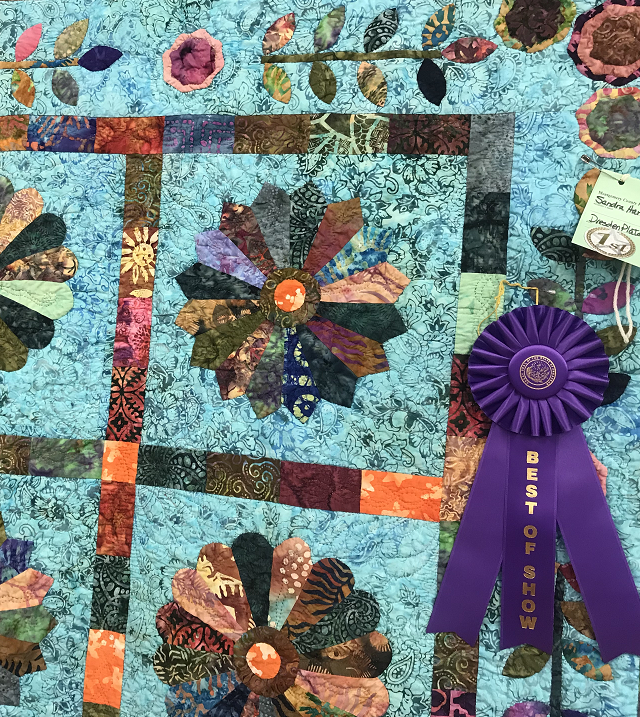
Inspiring Creativity
QUILTZ FAIR - Are you in stitches yet?
The annual three day Quartz, Quiltz & Craftz Festival
is held at the Montgomery County Fairgrounds, Mount Ida, Arkansas the second
weekend in October and has been rated in the top four events in Arkansas for
many years. 2011 will be the 31st Quiltz Show is sponsored and coordinated by the
Montgomery County Cooperative Extension Service - EH (Extension Homemakers) Clubs of Montgomery Co.
AR. Approximately 150 of the most beautiful quilts in the state will be on
display. A great display of small and large quilts. The Lake Ouachita Craft Guild sponsors the Craft
Show. One year a lovely painting of the
Quilt Show appeared on the cover of the Arkansas Tour Guide. Often a quilt is
donated by a club and raffled off as a fund raiser. My mother-in-law, Minnie, in Oden turns out four large
beautiful quilts nearly every year. In 2009 she entered two into the fair
as the exhibit was a bit skimpy and came in second with both and four into
the Quiltz Show. Ever wondered how many hours of handwork goes
into making one quilt let alone two hundred?
To enter in the Quiltz Show take your quilt or quilts to the
Montgomery County Fairgrounds between 9am and noon on Thursday before the show
weekend. You can enter any number. Fill out the registration form so a
display card can be made with the name of the owner, who quilted it and year
quilted. The show is open Friday, Saturday, Sunday. Pick up your quilts Sunday
between 4:30 and 5pm. There is no judge, the fair visitors are invited to
select their choice for most beautiful quilt, 'Viewer's Choice Award'.
Most quilts are just for show, but you can sell quilts if you want. The
committee add 20% to what you ask. Antique quilts, new quilts, big or small
are welcome. View a working quilting exhibit by a local quilting club,
participate in the quilt block challenge, enter a raffle for a donated quilt.
The quilt show for October 2000 had lots of new quilts but most of them were
traditional patterns. The 2000 winner was the same quilt as the previous year - floral
applique with lots of 3-dimensional features (stuffed grapes, gathered
flowers, etc). The people's choice award for 1998 went to a beautiful quilt
with a white background featuring a large butterfly in the center surrounded
butterflies on twelve squares. In 2004 the Extension Homemaker Club donated a
large right homemade quilt to the Festival made by members of the Silver Piece
Corp. The design was old churches, barns and birdhouses.
2006
quilts
2007
2009 there were some cheater quilts for sale i.e. a quilt made from
preprinted fabric panels. Not hand or machine pieced.
2010
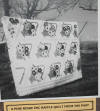
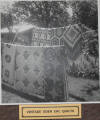
At the Heritage House Museum in Mt Ida you can see old photos of
quilts put to different uses.
This year, 2010, was the 30th EHC quilt show (Quartz, Quiltz & Craftz
Festival) in Oct. at the Mt. Ida Fairgrounds. The next quilt show will be
Oct. 14-16, 2011 featuring over
100 quilts in numerous categories. The quality is always high. No cheater
quilts. The Montgomery County Fair and Livestock Show August 8, 2010 -
August 14, 2010 usually has a few quilts displayed.
"Stain Glass Window" Longest quilt I made.
It took a long time to draw the pattern. I found it in a magazine and had to
enlarge it. Had it in the Mt. Ida Quilt Fair. Full Size. Pieced. It was fun to
make. Minnie.
MUSEUM
Friendship quilts are created as a keepsake among community
members, church members or family. There are several
"friendship" and "memorial" quilt patterns e.g. where everyone contributes a block and
signs it or signatures go down a strip in the middle or same pattern turned
different ways. Such a quilt was very versatile as to the event marked or the
person honored. The Heritage
House Museum, Montgomery County, Mt Ida does have a display on quilts. One of
the quilts that has been donated is a "Friendship Quilt" made in
1932 with approximately 188 names of families from the Oden area. Other
"Friendship Quilts" include one from the Sims Church of God and
another from the Mt Ida Baptist Church.
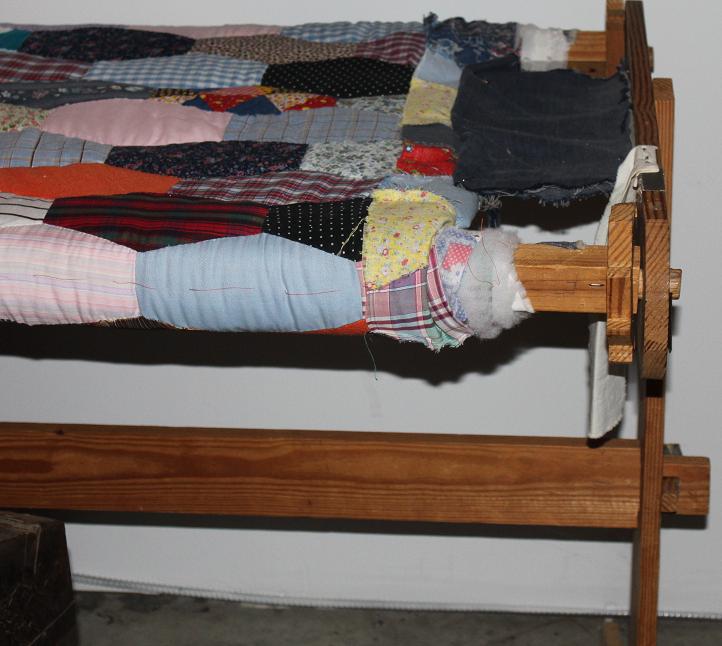
To store; It is better to roll a quilt then fold it.
"When this flour is changed to cake,
Here is something else to make.
With a needle and some thread.
Make a quit for baby's bed."
TEXT on TEXTILES
Words in designs can be found on quilts from the
classic
signature
quilts to works of art featuring prose, poetry and Biblical scripture
are not uncommon, e.g. Hand pieced across the entire "page" of the quilt
"Gather up the fragments, let nothing be lost, behold I come quickly and my
reward is with me. John 6:12. I have seen a celebrity autograph quilt, a
wedding greeting embroidered crazy quilt "Fond Memories of our wedding
across the to with the bride and grooms name and date and below notations
and names, a US map quilt with the quilting embroidered marking the rivers
and mountain ranges and capital cities, a subscription quilt - used as a
fund raising project for a church group summer activity with names and
businesses, a zodiac pieced, embroidered and applique quilt, county fair
prize ribbon quilt, a 1920s an organized crazy quilt with names, a quilt
with suiting swatches and signatures on each swatch, a quilt with hand
writing the same - so someone was appointed in charge of transcribing the
names of a list of donors, a remembrance of a community and was dated, a
1920s nursery rhyme quilt with pieced 1"
precise small squares, to generate a realistic image, like the pixels with
our computers today, a topsy turvey alphabet quilt, a red and white
Christmas quilt Joy, Joy, Joy 2007, and a caricature quilt initialed or
signed.
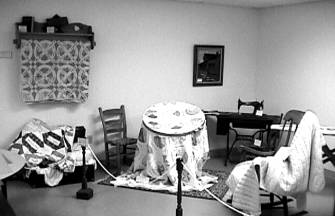
"Quilts provide historic and cultural information
through not only their design but also through their use of materials and the
color of those materials."
"A "Friendship Quilt" was a
traditional presentation gift in the Oden community. I remember my mother
working on one or two, and as I recall they were connected to the departure of
our pastor(s). The ladies of the church would get together and each would
piece a block of a mutually selected design; each block would also be
embroidered with the lady's name and the date that it was pieced. The
ladies would then put all the blocks together to form the "top."
Once this was done, they would have a quilting bee to finish the gift. I'm sure this project created social occasions for the ladies and was a way of
showing their appreciation, as well as a keepsake for the pastor with the
names of the families of that congregation. The quilt was presented and
displayed for all to admire at a farewell service. I believe friends of a
bride used this type of quilt as a gift also." Information
contributed by Dixie Oct. 10, 2000. There are two signature quilts in the
photo above, to the left. Many patterns are available, e.g. a diamond grid
with signature in middle.
Someone dying of cancer sent a block of
"gorgeous red" fabric to all her friends, asking them to decorate their
section to be later joined together into a quilt - which she did herself.
The quilt illustrated another side of the highly creative person.
"Quilts are more than just plotted art forms, they
contain important links to our history and heritage."
SCHOOL
A 5x5 square block quilt, made to commemorate the graduating
class from Oden High School in 1961 was rediscovered in Y2K. Mr Ray Irons,
1917-1960, principal and the coach along with four students including his son
Gary Irons, William New, Ken Lawrence and McArthur Spurling, students, died in
a tragic automobile accident while returning on the evening of February 24
1960 with the basketball team. The quilt in orange, black and white squares,
the school colors, was made by Ophelia Ballentine when she was 72. The
quilt was a graduating gift to her grandson. Each black corner block contain
the names of those who died and the other blocks contain the names of the graduating
students as well as A.L. Banta ; Agri; Ode Maddox - Superintendent; Maxey
Irons - Librarian; and Bill Abernathy - Principal 1960-1961, Roger Maddox
pupil. An article on this quilt appeared in the Montgomery County
News April 20, 2000. The baseball field at Oden High School is named in
memory of the Irons family.
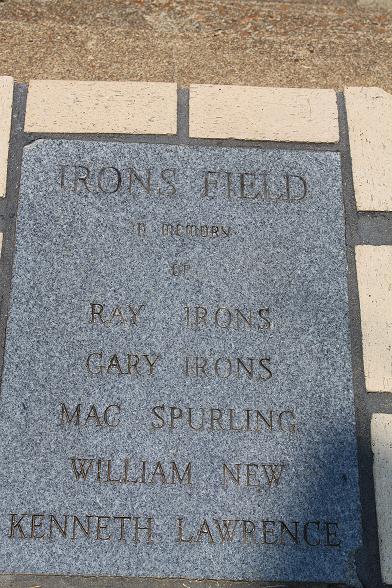
Quilts are given away to family members on special occasions.
e.g. When my husband graduated from Oden High School in 1975 he received a
quilt handmade by his grandmother so did each of the other twenty grandkids
when they graduated and now his mother is making quilts for her grandkids as
they graduate from high school - the Bow-tie pattern for the boys and the
Sun Bonnet Sue pattern for the girls. The children's tee shirts with logos
from band, orchestra, school, soccer, scouts, swim team etc. can be
made into a quilt top.
Today a quilt that is not hand pieced, not hand
quilted, and not 100% cotton, is still considered a "real" quilt.
ARKANSAS 1941
Arkansas -A Guide to the State
Compiled by Workers of the Writers' Program
of the Work Projects Administration in the State of Arkansas
First published in 1941
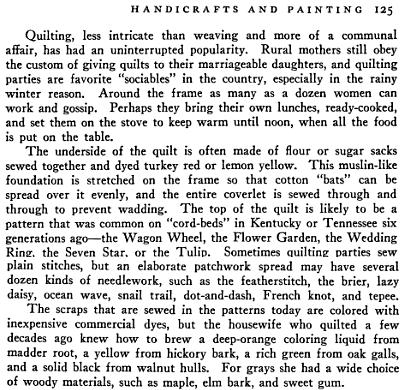
When the wail of a train whistle rose above the remote
ridges the sounds of home industry faded, and handicrafts began to vanish
from their last stronghold, the hill country. People started to wear
factory-woven jeans and 'store boughten" Sunday suits instead of frontier
homespun dyed grey, red and brown colors. Hosiery from Eastern mills
replaced socks tediously knitted by firelight. In 1910 nearly every spinning
wheel (whether for flax, cotton, or wool) had fallen apart or was gathering
dust in the attic. The country craftsman, although he may not use his lore,
still knows the art of making many household furnishings. He knows that the
time to slice hickory sapwood for chair-bottom splints is when the leaves
are the size of squirrels' ears," and he remembers that if you want to make
a basket of honeysuckle and bush runners you should rip up the materials
from roadside ditches and rail-fence corners between September and March.
Such a farmer is pretty sure that the ax handle he carved from hickory
during an idle afternoon is better than the ones he helfted at the town
hardware store last week, and he is convinced that water is at its best when
sipped from a gourd dipper. The cornhusk doormat that his wife wove in an
over and under pattern is familiar to him, and when he is resting after
supper he silently admires the sewing basket that his wife fashioned from
pine needles. Perhaps he has seen a chair bottomed with strips of inner tube
and is deciding to make a seat like it.
GARAGE SALE
Rosie's Ribbon Quilt

Now it keeps me warm at night,
Rosie's old worn ribbon quilt.
Pieces gleaned from floral sprays;
Squares of colored silk.
Niece Juanita held the sale,
I spotted that old cover,
The quilting crude,
The edges frayed,
And I bought it for a dollar.
Old Rosie lived in Arkansas,
Happy, proud and poor,
She sewed that lovely Texas Star,
Now gone, she'll quilt no more.
Written by Laura Willhite
Posted here with Laura's permission
Rose Mullenix was born 30 Nov. 1895 at Oden and attended the
Hog Jaw School. She married Lee Singleton in 1919. Rosa A. was buried 27 June,
1986 at Brushy Cemetery.
This cherished quilt, although showing its age, will be passed down to Laura's
grandson.
Quilt tops can often be picked up at garage sales and you can
easily take them along to a sewing center for a backing and quilting.
"As I look at the quilts, I see fabric from my
mother's dresses, fabric from my father's shirt's, fabric from my little
outfits."
HOME
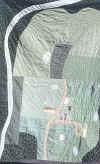 "Redbud
Acres" 4' x 3' made in 1991. The backing sheet is Holstein
cattle pattern as the white building in between the ponds is the dairy barn.
Minnie made each of her grandchildren one of these pictorial 'play
quilts'. The Ouachita National Forest borders the property, the dark
green strip either side of Little Brushy Creek.
"Redbud
Acres" 4' x 3' made in 1991. The backing sheet is Holstein
cattle pattern as the white building in between the ponds is the dairy barn.
Minnie made each of her grandchildren one of these pictorial 'play
quilts'. The Ouachita National Forest borders the property, the dark
green strip either side of Little Brushy Creek.
A quilt is a sandwich - top, batting and backing.
QUILTING
One week to piece on machine (20 to 30 hours) or one month to piece
by hand according to what pattern you use. Use a
seam - take two blocks, lay pattern
side together, with plastic ruler measure in a mark with a chalk pencil and sew along that line. Store chalk
pencils in the freezer. Makes them easier to sharpen otherwise they just
crumble. Average two months to quilt a
quilt. Minnie cannot quilt without a thimble and needs to quilt on a frame to
keep the batting taut. She has quilted a lot of quilts from backs of chairs
and made frames herself. You can quilt by the blocks or lines or
patterns e.g. heart, start, or whatever you
want. Just fill it in. Use a slick heavy cotton quilting thread and a small
needle. Polyester thread is okay on a baby quilt, a quilt that will be
loved to bits and washed to pieces but not on a show quilt. Polyester thread
can cut through cotton fabric so cotton quilting thread is better. A twelve inch block
takes one to one and half hours to quilt. Batting can be bought by the yardage
or package. Bonded is for placemats and Hiloft is for comforters. Average
quilt materials cost $75- $100. Minnie uses large cotton patterned sheets to back her quilts.
A few of the patterns Minnie has made over the years
Bow - tie - very colorful boys high school gradation gift
-2008
Butterflies - appliqued
Christmas
Dalihia
Fan
Fiesta -two fan patterns used
Fisher boys
Friendship Quilt
Irish Chain - beautiful, green with a white background
Log Cabin
Old Mill
Spinning Stars
Sunbonnet Sue
Migration - interesting pattern. Colors fade from dark blue to light colors
Grandmother's Flower Garden
Christmas star
Stain Glass
Sunbonnet Sue
Tulip
During the depression quilting had a revival and flour still came in sacks, girls school dresses were
made out of those flour sacks and when the dresses were out grown they were
cut up and made into a quilt top. Small-print fabrics and
pastel palette where typical of the depression era quilts. The flour sacks
with the print material was a brand that cost a few pennys more than the
cheaper brand. Many women would not go to town in a homemade flour sack dress
but as soon as they arrived home would change into those work clothes. Feed and flour
stacks, often embroidered, and dress material were patched together in the same
quilt top. It was not unusual to see a frayed quilt become the padding for a new
quilt by adding a new top and bottom. That's recycling! A Y2K study shows that
$1.836 billion is spent on quilting annually in the USA, an increase of more
than 50% since 1997. Research shows that 1% of quilters are male.
Wedding Ring - a country
icon.
A classic quilt pattern is the interlocking rings of the Double
Wedding Ring. The rings are made from snippets of fabric found in a scrap
bags. The design was ideal for the Depression and war years. "The vogue
for quilts has swept the country," the Missouri Rualist decided on
February 1, 1931. "One fair had 161 entries of the Wedding Ring design
alone." Among the reasons this pattern enjoyed such popularity were the
endless design opportunities it offered quilters, including pastel-on-white,
solid-colour backgrounds, two-tone rings e.g. patriotic two-toned red &
white rings on a blue background, nine-patch variation of the wedding ring.
included scraps in the centers instead of the outer ring, and scalloped borders. The wedding ring was
a joyous symbol in what were hard times. The pattern's message is 'hope for
the future.' The designed first appeared in the 1920s and in the 1930s and
'40s the pattern reached its height of popularity and countless
variations
were printed in newspapers and magazines.
"I can't image ever getting tired of this
pattern."
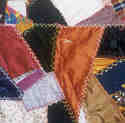 Pre
1950s newspapers were used, patterns came in them, and the pattern was also
cut out of newspaper. e.g. Cats Eyes quilt still had the
newspaper on the back when Minnie started to piece the top. Since the 1950s
polyester has been used as the batting. When cotton was used you had to quilt
a whole lot closer to stop the cotton from wadding. Cotton is much harder
to quilt through. Minnie remembers when she was young going with her mother to
different homes and quilt all day long. They could quilt a quilt in one day.
They would bring a casserole dish each. In those days to get a quilt out
of the way they would hang the frame from all four corners from the ceiling
and roll it up and down. Cordie quilted an hour or two at a time, all work by
hand and used frames. She would cut little squares from the material from old
worn out shirts and the girls dresses. She would buy the cotton and card it.
A crazy quilt is a quilt made with out a pattern, and it was
made out of dress material like satin, taffeta, velveteen, but not cotton,
with different embroidery stitches all around. Poem
Pre
1950s newspapers were used, patterns came in them, and the pattern was also
cut out of newspaper. e.g. Cats Eyes quilt still had the
newspaper on the back when Minnie started to piece the top. Since the 1950s
polyester has been used as the batting. When cotton was used you had to quilt
a whole lot closer to stop the cotton from wadding. Cotton is much harder
to quilt through. Minnie remembers when she was young going with her mother to
different homes and quilt all day long. They could quilt a quilt in one day.
They would bring a casserole dish each. In those days to get a quilt out
of the way they would hang the frame from all four corners from the ceiling
and roll it up and down. Cordie quilted an hour or two at a time, all work by
hand and used frames. She would cut little squares from the material from old
worn out shirts and the girls dresses. She would buy the cotton and card it.
A crazy quilt is a quilt made with out a pattern, and it was
made out of dress material like satin, taffeta, velveteen, but not cotton,
with different embroidery stitches all around. Poem
"Objects of both utility and beauty, quilts become
documents that reveal information about the individuals and society that
produced them."
BOOKS
 Johnson,
Mary Elizabeth Prize Country Quilts, Oxmoor House, Inc., 1977
features a quilt made by Anna May Rowell Duke of Black Springs "Mountain
Homestead". Includes the pattern and her own story. Mrs Duke was
a fourth and fifth grade teacher at Norman in the mid 1940s. During the winter
of 1930-31 Anna May, 21, started her first teaching job at Greasy Cove and was
boarded out for three years with an elderly couple, Mr & Mrs Ruben Porter,
in a small unpainted house on a farm cleared from the forest. From them
she learnt to sing folk songs, to carve spoons and wind vanes, and to piece
and quilt and find peace. The color image is not true, the browns should be
teal. The quilt is pieced with each flower appliqued on.
Johnson,
Mary Elizabeth Prize Country Quilts, Oxmoor House, Inc., 1977
features a quilt made by Anna May Rowell Duke of Black Springs "Mountain
Homestead". Includes the pattern and her own story. Mrs Duke was
a fourth and fifth grade teacher at Norman in the mid 1940s. During the winter
of 1930-31 Anna May, 21, started her first teaching job at Greasy Cove and was
boarded out for three years with an elderly couple, Mr & Mrs Ruben Porter,
in a small unpainted house on a farm cleared from the forest. From them
she learnt to sing folk songs, to carve spoons and wind vanes, and to piece
and quilt and find peace. The color image is not true, the browns should be
teal. The quilt is pieced with each flower appliqued on.
Miss Anna May wrote "I remember the tool-shed and forge next to the
road, the well-house and smokehouse to the side, and the barn in the back. In
spring and summer the yard and the garden boomed with flowers; the little
fields were cleared and planted where the ground was most level; the hillside
orchard was pink and white with peach and pear blooms; and all around, the
rail fences kept the dogwood-laced forests back with zigzag lines. Little
farms and the people who made a living from them are non-existent now, but
their memory tells a time when life could be savored to its fullest, and peace
could be very real and God very close in the quietness of a little homestead
surrounded by trees."
'Montgomery County: Our Heritage' Vol. 2 page 739 & 1072
Write up on the quilt and Mrs Duke (1912-1980) with her photograph.
Oklahoma Quilt Heritage Project Oklahoma Heritage Quilts : A Sampling
of Quilts Made in Brought to Oklahoma Before 1940 / pb / published 1989
ISBN: 0891459456 features 200 quilts made before1940 including the "Rainbow
cactus basket of diamonds" made during the depression years by Verlinda
Isabelle Standridge Goodner. "She was very particular about the cotton
batting and carded each rectangle and laid them on the lining".
Civil War items
Date a quilt by the youngest fabric not the oldest. Many
quilters hold on to fabric for years.
PHOTOGRAPHS
Take photographs of your quilts
before they wear and before you give them away as a graduating, wedding or a
Christmas present. Create a portfolio and date your work. Date & initial your quilt and maybe add a message.
"Adds a little bit." Write it with chalk, embroider then dust
off the chalk. Some baby crib quilts are loved to shreds and photographs will
be your only memories.
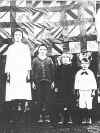 Years
ago quilts were often used as backdrops for picture taking. Many families
probably have photos of grandparents and family in front of a quilt. This
photo was taken around 1920 at Hog Jaw. The children, Ocie, Owen, Audie and
Arnold Whitehouse, were born in 1907, 1910,
1913 and the youngest boy was born in 1915. Their father was buried at Oden in
1922. The museum has photographs featuring quilting in progress, quilts
on a line and quilts used like this as a backround.
Years
ago quilts were often used as backdrops for picture taking. Many families
probably have photos of grandparents and family in front of a quilt. This
photo was taken around 1920 at Hog Jaw. The children, Ocie, Owen, Audie and
Arnold Whitehouse, were born in 1907, 1910,
1913 and the youngest boy was born in 1915. Their father was buried at Oden in
1922. The museum has photographs featuring quilting in progress, quilts
on a line and quilts used like this as a backround.
"Interview with a tape recorder and photograph quilters and record
their personal memories right on the spot! Quilts have been doing since the
first quilt was made - carry messages, make statements and tell tales."
"Slave quilts patterns made pre Civil War provided more than warmth and
beauty - the quilts were encoded with messages on how to gain freedom.
Slaves could lay out the quilts without suspicion to give each other
directions for escape using simple patterns such as the monkey's wrench
(showed that the slaves were getting their tools ready, preparing to leave),
the wagon wheel, the bear paw, the flying geese and the tumbling black.
To the untrained eyes, the quilts seemed nothing more than a beautiful
entourage of colors. Each plantation had a set of symbols usually shown
on a sampler quilt."
PUBLIC QUILTS
Quilts are often found around town in the local libraries,
churches, schools, nursing home facilities council offices, often donated to
mark an anniversary, memory or a logo for an organization or for decoration.
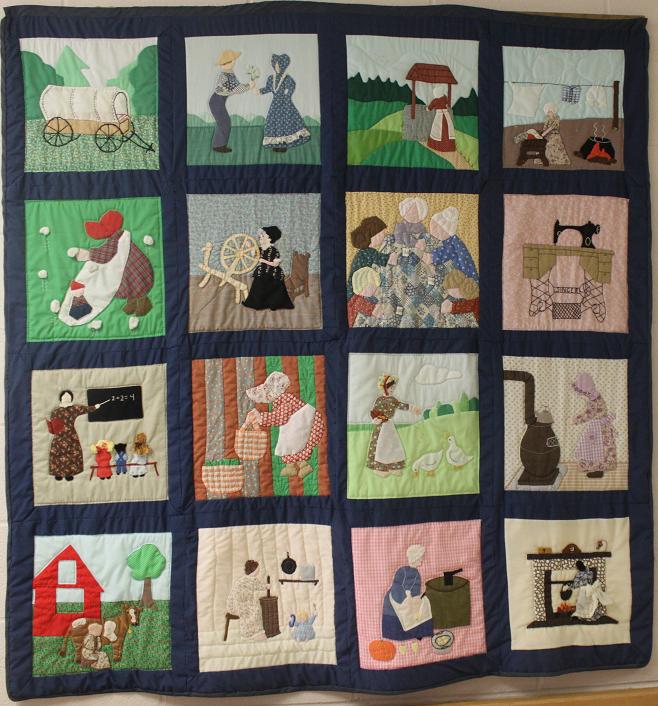
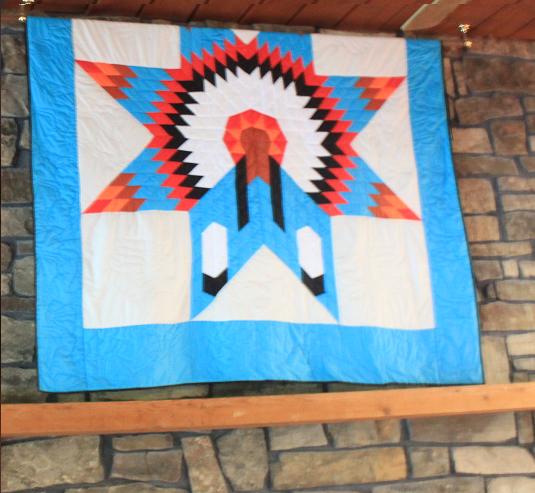
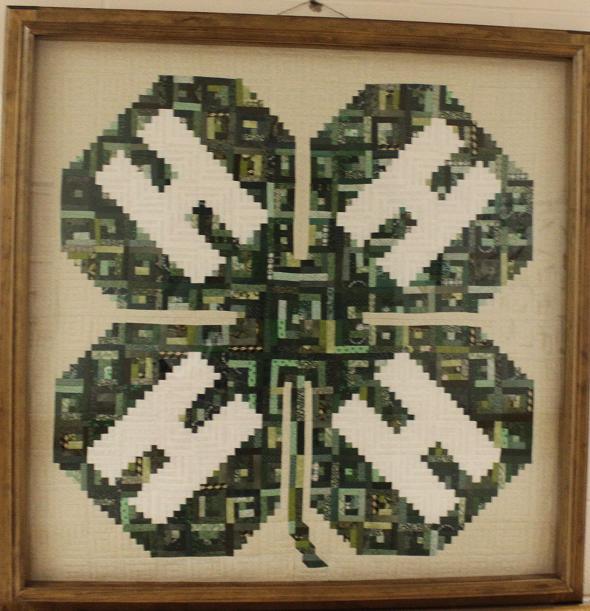
STORAGE
The best place to store quilts is flat on a guest bed one on top of each
other. Consider covering windows with a UV-filtering shield or glass. If stored in a cedar chest keep the material away from the wood and
once in a while take the quilts out and refold a different way. Old quilt
blocks look good in a twin matted frame. Hanging a quilt is stressful, no
matter how it is done. Cover the wooden dowel with cloth a sleeve. Risks include uneven stretching, fading and torn
stitches. Should never be done permanently. Keep in mind the environmental
factors in the room e.g. light, fireplace smoke, heat and dust. Rotate pieces
hanging from a different edge every three months and also alternate displays
allowing one to rest flat while something else goes on view. Maybe back
the quilt with a 100% cotton sheet to protect the quilt from a painted wall.
Condition is everything.
CLEANING
If it smells musty, air it. Spot clean by patting an ice cube wrapped in a
tea towel but be careful you might get a tide line. Gently vacuum clean the
quilt with the upholstery attachment covered with cheese cloth or vacuum lean
through a fiberglass screen square (cover rough edges with twill tape) obtainable
from hardware stores.
Consider wet washing an antique quilt as a last resort. Some old quilts
have cotton that has not been carded well and if seeds present they might
stain the quilt if wet washing has not been done before. If
you do wash a quilt use a bath tub and 6" of tepid water and if you use a
detergent rinse at least three times. Fabric may not be colour fast, can
shrink at different rates and stitches may pucker. Dry cleaning is not
recommended.
"Quilts are an art form and meant to be handed
down"
GLOSSARY
Sewing
terms
Quilt
terms
Workmanship, aesthetics and condition are important not
the age of the quilt.
"If your image of a serious quilter is a grandmotherly
type bent over a stretched-out quilt taking tiny stitches, rub your eyes and
look again. She's probably sitting at her laptop computer calling up quilting
web sites to find out about new products, learn new techniques, collect free
patterns and purchase materials online. Quilting may be an American activity
tied to our history, but today's quilters are anything but old-fashioned.
While most of the work is still done by hand, quilters love all the fancy
sewing machines and gadgets adding to the quilting adventure." Houston
Chronicle 28 Oct. 2000
"Quilts remain a quintessential art form that
reflect the changing styles and tastes over three hundred years of American culture."
Two quilt classes:
1. Special heirloom quilts, for show and
tell.
2. Everyday quilts are made for function, easily washable and enough batting for
warmth. e.g. Double knit quilts, denim picnic quilts, blue jean quilts, old silk
ties, and today soccer shirt quilts and tee shirt quilts.
Cover Stories: Quilts and throws are much more than
functional necessities to ward off the cold on winter nights or hide shabby
pieces of furniture. They are reflections of the skills and identities of their
makers. They exemplify the techniques of traditional patchwork craft and exhibit
a range of styles from plain and functional to elaborate and fashionable. To
many they are nothing short of works of art.
Exhibits feature artwork painted with needle, thread
The Arkansas Democrat Gazette 17 January 2008
"The Great Arkansas Quilt Show II" at the Historic Arkansas Museum has more than
90 quilts hanging on the walls and from the ceiling, many with designs as
elaborate as paintings. According to a 2006 survey commissioned by Quilts, Inc.,
there are more than 27 million quilters in the United States, who spend $3.3
billion annually on their passion. Quilting is not a thing of the past and there
are many fans of quilting. Many quilts today are art quilts and few are made for
truly functional use. Years ago creativity had to take a back seat to creating
something that would keep the family warm. Historically, any woman who was
involved in domestic activities didn't leave time for artistic creativity. But
quilting is the best of both worlds because it's form and function. Early quilts
were also limited by the materials available at the time. Many of the quilts are
family quilts made by daughters, mothers and granddaughters collectively. Family
quilting served as a practical way of spending time together and was used to
pass down skills and techniques.
Quilting is also proving to be a creative art form alongside
other types of art, as quilts become more decorative. Quilts are usually
appraised for insurance purposes, but also to determine the correct value if a
person wants to buy or sell one. The value of a quilt depends on several
factors. When you appraise an antique quilt, do the value on what it would cost
to replace the quilt with a similar one and with a new quilt base it on how much
it would cost to remake the quilt, because you can still buy the same material
to make it. Appraisals are helpful so one day their children won't sell
grandma's quilt at a garage sale for $10. Family history is important.
Quilting was a family tradition in families in southern Arkansas. Quilts also
let us know what was available as material resources in certain regions. Many
quilts have a story that goes along with it. Quilting is very labor intensive
and very love intensive. Each quilter loves their quilt and can sit down and
talk to you for hours about the process of making it.
Making of a mystery quilt.
A group of friends, organised by just one..... decided to participate in the
making of a mystery quilt. the fabric choices were made and the first set of
instructions arrived, then the second and the third and so on! Each month we
assembled the block by instruction, with no idea as to what the final result
would be. there were many guesses but we were all so far off the beaten track
when the last of the instructions were delivered and the design was revealed! A
marvellous project to accomplish with a great group of friends, fun and
motivating.
A "call for hearts" was a tradition within quilting groups
where members send a small quilt block with a healing heart on it to provide
support to someone who might be going through a difficult time. Six and a half
inch blocks of cream fabric with a heart sewn on.
Throw sized memory quilt from old clothes.
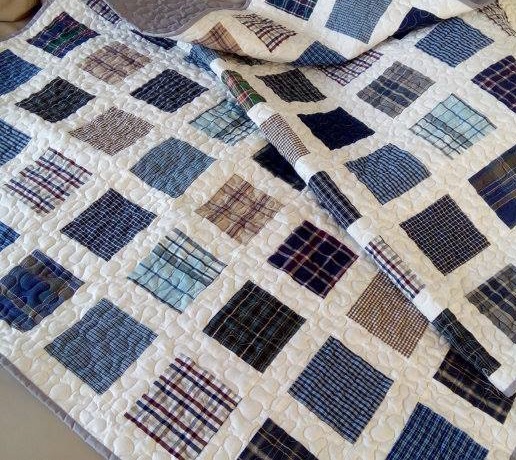
The Clothesline Said So Much:
A clothes line was a news forecast to neighbours passing by.
There were no secrets you could keep when clothes were hung to dry.
It also was a friendly link, for neighbours always knew,
If company had stopped on by to spend a night or two.
For then you'd see the fancy sheets and towels upon the line;
You'd see the company tablecloths with intricate design.
The line announced a baby's birth to folks who lived inside,
As brand new infant clothes were hung so carefully with pride.
The ages of the children could so readily be known
By watching how the sizes changed you'd know how much they'd grown.
It also told when illness struck as extra sheets were hung;
Then night-clothes, and a bathrobe too, haphazardly were strung.
It said "Gone on vacation now", when lines hung limp and bare.
It told "We're back!" when full lines sagged with not an inch to spare.
New folks in town were scorned upon, if washing was dingy grey,
As neighbours raised their brows, and looked disgustedly away.
But clotheslines now are of the past, for dryers make work less,
Now what goes on inside a home, is anybodies guess.
I really miss that way of life; it was a friendly sign,
When neighbours knew each other best, by what was on the line.
Author Unknown
Apron Strings
The principal use of Grandma's apron was...
The principal use of Grandma's apron was to protect the dress underneath,
but along with that, it served as a holder for removing hot pans from the
oven; it was wonderful for drying children's tears, and on occasion was even
used for cleaning out dirty ears.
From the chicken-coop the apron was used for carrying eggs,
fussy chicks, and sometimes half-hatched eggs to be finished in the warming
oven. When company came those old aprons were ideal hiding places for shy
kids; and when the weather was cold, grandma wrapped it around her arms.
Those big old aprons wiped many a perspiring brow, bent over the hot wood
stove. Chips and kindling-wood were brought into the kitchen in that apron.
From the garden it carried all sorts of vegetables. After the peas had been
shelled it carried out the hulls.
In the fall it was used to bring in apples that had fallen
from the trees. When unexpected company drove up the road, it was surprising
how much furniture that old apron could dust in a matter of seconds. When
dinner was ready, Grandma walked out on the porch and waved her apron, and
the men knew it was time to come in from the fields for dinner. It will be a
long time before anyone invents something that will replace that old-time
apron that served so many purposes.
Oh, she always wore an apron!
At home, Oden, "Grandma Whitehouse", Cordie Willhite, always wore an apron.
It was unusual to see her without one on except when she was out. She was
always busy doing something. Often sewing. She sewed the clothes for the
children. For a while she had a thing about making mats out of the plastic
bread sacks. It sure took a lot of sacks. She would twist the plastic bag to
make like a rope and then knot another end on to the end and continue. When
long enough she would start in the middle and work out in a circle pattern
and somehow make a floor mat by crocheting it. She was always after flies
with her fly swatter. Grandma Whitehouse use to make the best cornbread
always thick, fluffy and moist. This was a daily treat and it was biscuits
and gravy for breakfast. She used to fix the biscuits for granddad every
morning; he would put them in his coffee and called it "soak". Grandma
dipped snuff since she was a little girl, Sweet Grarret and Sons for as long
as I can remember. The last apron I remember her wearing was a pink and
white gingham waist apron with one pocket, not ruffled.
Work day aprons with bib fronts are practicable - worn to
cook, clean house, sew and garden. Then there are everyday aprons and fancy
aprons. Some aprons have fancy embroidery or applique's that double as
pockets. Most aprons, were simple to make, are made by women of the house
and incorporated their own ideas into the apron. Granny Ada made bib aprons
and gave them to all of us as Christmas gifts - now well used and stained.
It has a green pattern on a white background, edged with green bias binding
with four green ties and two large deep pockets. Another year we all got BBQ
aprons - men's and women's styles. Aprons, quilts and hats during the
depression have been known to be made from feed sacks. Aprons, an
utilitarian garment, are not just for wearing, they are now a collectible
item, found as seat skirts, curtains and in shadow boxes.
Otago Witness 11 Oct 1873, Pg 19
Patchwork
I feel that I must be getting old - for I turn'd fourscore -
And the children wonder that day by day I can over my patchwork pore;
But each neat square, as I sew it in, has a tale of its own to tell,
And I often live in the past as I gaze on patterns I once knew well.
That bit of pink was the first new pink ever worn by my little Jane;
Ah, me! She is wrinkled and widow'd now, and will never wear pink again;
But I see the smile on her father's face as he fondled her on his knee,
And he said, as he pinch'd her dimple cheek; she would grow up just like me.
And that is a piece of the dress I wore on the day that my lover came,
Asking me - I was then eighteen - to share his home and name;
I heard his footstep, and well I mind that, as my gown I hook'd,
I gave a sidelong glance at the glass, and thought how nice I look'd.
And there is bit of another dress that I wore on day in spring,
When the hand that will never clasp mine any more on my finger placed this
ring;
And well I remember how rosy I bush'd at the compliments he would pay;
But, of course, I did look pretty, I know, in my suit of silver-grey.
Silk! No, child; in those olden days a good strong print or a stuff
For a village lass - though I was the belle - was consider'd grand enough;
And somehow, I think it were better now if maidens spent less in show,
But I am old-fashioned, and my ideas were moulded too long ago.
Ah, child, how short life seems at the most, now I sit in my mother's chair,
And sew a bit of the old, old dress that I saw her mother wear -
This red and brown with the yellow scroll, thought handsome once, I ween;
But the patterns they made when I was a girl are seldom now to be seen.
Oh, the changeful years, the changeful years! That fragment of white and
blue
Is a bit of the frock that my daughter's child for her babe has just bought
new;
And I sit and muse of the present and past till my head sinks down on my
breast,
And I wonder who would go on with this quilt if Granny were laid to rest.
Mary Frances Adams
Montgomery County
ARGenWeb Project
 Every
year in August the Montgomery County Fair is held. The Bobo Family
Quilt won a Best of Show in the Senior Adult Center division for Y2K.
It depicts the descendants of John Frederick and Minerva BOBO family. Mattie
Lucille Bobo White, 3rd from the bottom, oval picture in the center row, (near
the tip of the ribbon) family block is in the same row with three squares to
the right with all the little oval pictures are her children, grandchildren
and great grandchildren. The Bobo families contributed the picture blocks and
Maxine Wornick of Norman and Ollie Hays of Black Springs pieced and quilted. The Bobo reunion is held every year in
September at Beavers Bend State Park in
Oklahoma. This year, 2000, was the 27th year for the reunion and the
quilt was
auctioned off. A photo of the quilt, 98" x 109", appeared in the Montgomery
County News 31 August 2000. Another Bobo Reunion Quilt won Best of Show in
the 2001
Montgomery County Fair and was auctioned off at their annual reunion.
There is a good Forestry Museum at the Beavers Bend State Park, OK.
Every
year in August the Montgomery County Fair is held. The Bobo Family
Quilt won a Best of Show in the Senior Adult Center division for Y2K.
It depicts the descendants of John Frederick and Minerva BOBO family. Mattie
Lucille Bobo White, 3rd from the bottom, oval picture in the center row, (near
the tip of the ribbon) family block is in the same row with three squares to
the right with all the little oval pictures are her children, grandchildren
and great grandchildren. The Bobo families contributed the picture blocks and
Maxine Wornick of Norman and Ollie Hays of Black Springs pieced and quilted. The Bobo reunion is held every year in
September at Beavers Bend State Park in
Oklahoma. This year, 2000, was the 27th year for the reunion and the
quilt was
auctioned off. A photo of the quilt, 98" x 109", appeared in the Montgomery
County News 31 August 2000. Another Bobo Reunion Quilt won Best of Show in
the 2001
Montgomery County Fair and was auctioned off at their annual reunion.
There is a good Forestry Museum at the Beavers Bend State Park, OK. 







 Pre
1950s newspapers were used, patterns came in them, and the pattern was also
cut out of newspaper. e.g. Cats Eyes quilt still had the
newspaper on the back when Minnie started to piece the top. Since the 1950s
polyester has been used as the batting. When cotton was used you had to quilt
a whole lot closer to stop the cotton from wadding. Cotton is much harder
to quilt through. Minnie remembers when she was young going with her mother to
different homes and quilt all day long. They could quilt a quilt in one day.
They would bring a casserole dish each. In those days to get a quilt out
of the way they would hang the frame from all four corners from the ceiling
and roll it up and down. Cordie quilted an hour or two at a time, all work by
hand and used frames. She would cut little squares from the material from old
worn out shirts and the girls dresses. She would buy the cotton and card it.
A crazy quilt is a quilt made with out a pattern, and it was
made out of dress material like satin, taffeta, velveteen, but not cotton,
with different embroidery stitches all around.
Pre
1950s newspapers were used, patterns came in them, and the pattern was also
cut out of newspaper. e.g. Cats Eyes quilt still had the
newspaper on the back when Minnie started to piece the top. Since the 1950s
polyester has been used as the batting. When cotton was used you had to quilt
a whole lot closer to stop the cotton from wadding. Cotton is much harder
to quilt through. Minnie remembers when she was young going with her mother to
different homes and quilt all day long. They could quilt a quilt in one day.
They would bring a casserole dish each. In those days to get a quilt out
of the way they would hang the frame from all four corners from the ceiling
and roll it up and down. Cordie quilted an hour or two at a time, all work by
hand and used frames. She would cut little squares from the material from old
worn out shirts and the girls dresses. She would buy the cotton and card it.
A crazy quilt is a quilt made with out a pattern, and it was
made out of dress material like satin, taffeta, velveteen, but not cotton,
with different embroidery stitches all around. 




